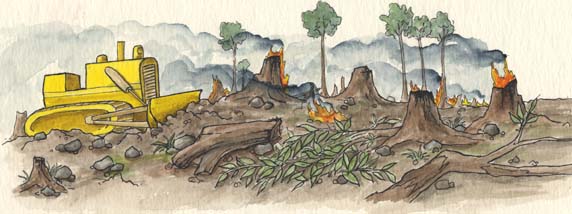

Losing wild habitats is very serious. Animals (and plants) need to have a place where they can live safely. Their habitat should have food, places to build homes and raise young. Humans need to use a lot of land. We clear land for farms and for building our homes and communities. Everyone needs a place to live. If we clear a forest or grassland, we always affect the wild animals that live there. If there is another wild place nearby, they will move there, but more often than not, they have no habitat to which they can move and that population of animals dies out. This is a very serious threat for animals that have limited habitat. If there is no other population of that species, they can go extinct.
The human race is growing. There are more than 6 billion of us on Earth! Over time, more habitats are destroyed to feed and house us. Even when we save small wild places between our towns and cities, these fragmented habitats often can't support populations of animals. Many animals will die out.
People have begun to save wild lands between communities to save the wildlife that live there. They will even clean up a place that was once developed and bring back the forest. These are being called wildways (greenways). They are trying to connect and stretch them from Canada to Mexico so animals can still migrate north and south the way they once did. Migrating birds and mammals need safe places to rest, eat and travel through all year round. Wildways may heal some fragmented habitats.
Support Greenways! Find out if your town or community is working to develop a greenway and join in.
(Included in PDF)
Habitat Loss - Read and React
1. Name two things that animals need from their habitat:
2. What is a fragmented habitat?
3. What is a wildway (or greenway)?
4. About how many people live on Earth?
_________________________________________________________________________________________
When you research information you must cite the reference. Citing for websites is different from citing from books, magazines and periodicals. The style of citing shown here is from the MLA Style Citations (Modern Language Association).
When citing a WEBSITE the general format is as follows.
Author Last Name, First Name(s). "Title: Subtitle of Part of Web Page, if appropriate." Title: Subtitle: Section of Page if appropriate. Sponsoring/Publishing Agency, If Given. Additional significant descriptive information. Date of Electronic Publication or other Date, such as Last Updated. Day Month Year of access < URL >.
Amsel, Sheri. "Habitat Loss" Exploring Nature Educational Resource ©2005-2024. December 13, 2024
< http://mail.exploringnature.org/db/view/1793 >
